What are Leaf Spot Diseases?
Leaf spot diseases are a collective term for a variety of fungal and bacterial infections that cause discolored lesions or spots on the leaves of affected plants. These spots can range in size, color, and shape and can compromise the plant’s health if severe.
Regions Impacted
Almost every region around the world is susceptible to some form of leaf spot disease. The prevalence and severity depend on local climate conditions, with humid and wet environments particularly conducive to the spread and growth of these pathogens.
What causes Leaf Spot Diseases?
Leaf spot diseases are primarily caused by pathogenic fungi, though some are caused by bacteria. These pathogens exploit the leaf’s surface and, once established, can quickly proliferate, producing visible spots or lesions. Here are the main causes of leaf spot diseases:
- Fungal Pathogens: The majority of leaf spot diseases are fungal in origin. The fungi produce spores that can be disseminated by wind, rain, insects, or even garden tools. Some common fungal pathogens include Septoria, Cercospora, Entomosporium, and Helminthosporium.
- Bacterial Pathogens: Bacterial leaf spots are less common than fungal leaf spots but can be equally devastating. The bacteria enter the leaf through natural openings or wounds, usually caused by wind, rain, or insect activity. The most common cause of bacterial leaf spots are by bacteria in the genera Pseudomonas and Xanthomonas.
- Environmental Factors: While not caused by a pathogen, certain environmental conditions can cause symptoms that resemble leaf spots. Factors such as water stress, sun scald, chemical burn from pesticides or herbicides, or nutrient imbalances can lead to spot-like lesions on leaves.
- Viral Pathogens: Some viruses can cause symptoms that mimic those of leaf spot diseases. They can be spread by insect vectors, infected plant material, or by the hands and tools of gardeners.
- Nematodes: These microscopic worms can cause foliar nematode leaf spots. The nematodes enter the leaf through the stomata (natural openings) and feed on the internal cells, leading to the appearance of leaf spots.
Types of Leaf Spot Diseases
Leaf spot diseases encompass a broad range of fungal and bacterial infections that manifest as discolored lesions or spots on leaves. Here are some notable types of leaf spot diseases:
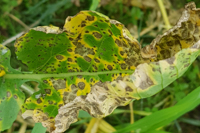 |
Alternaria Leaf Spot
- Alternaria Leaf Spot is a fungal disease caused by the Alternaria genus. It manifests as dark, round, or elongated spots with concentric rings on leaf surfaces. Over time, these spots may merge, causing premature leaf drop, impacting plant vigor and crop yields.
- This fungus affects a variety of plants, including Brassicas (broccoli, cabbage, cauliflower, brussels sprouts, radish, and kale), Cucurbits (cucumber, melon), onion, and garlic.
|
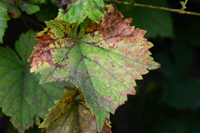 |
Anthracnose
- Anthracnose is a fungal disease affecting numerous plants caused by various fungi in the genus Colletotrichum. Irregularly shaped, dark brown or black spots on leaves are one of the most common symptoms. These spots may also appear on stems and fruits. Infected plants may develop wilting or dieback of branches, leaves, or entire plants.
- Maple, oak, dogwood, ash, and sycamore trees are particularly susceptible.
|
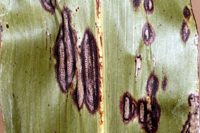 |
Ascochyta Leaf Spot
- Ascochyta Leaf Spot is a fungal disease that manifests as brown or purple blotches with irregular shapes appearing on leaves or pods. Stems exhibit dark lesions that can lead to rotting and eventual breakage. Affected leaves might wither and perish. Petals show signs of dark decay that can spread to the flower stalk.
- It affects many types of plants, including legumes (peas, chickpeas, lentils, and beans), grasses, and cereals (barley, oats, and wheat).
|
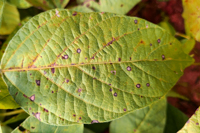 |
Bacterial Leaf Spot
- Bacterial Leaf Spot is caused by various bacterial pathogens, leading to water-soaked, brown to black spots on foliage. These spots can grow, merge, and cause leaf yellowing or premature drop. The disease affects various plants, often worsening in warm, wet conditions.
- Examples of host plants include astilbe, chrysanthemum, delphinium, echinacea, heuchera, marigold, petunia, rudbeckia, and zinnia.
|
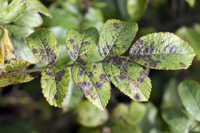 |
Black Spot
- Black Spot is caused by the fungus Diplocarpon rosae. It manifests as dark black spots with fringed or irregular edges on leaves, often surrounded by a yellow halo. Infected leaves may yellow and drop prematurely, weakening the plant over time.
- Roses are predominantly affected.
|
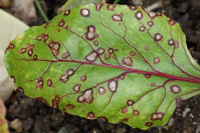 |
Cercospora Leaf Spot
- Cercospora Leaf Spot, caused by the fungus Cercospora spp., is characterized by small, circular to angular dark brown or reddish-brown spots on leaves. These spots may coalesce, causing premature leaf drop. It affects a wide range of plants, impacting their overall vigor and aesthetics.
- Beet, swiss chard, spinach, watermelon, melon, and cucumber are examples of affected plants.
|
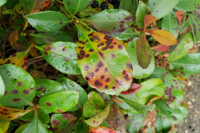 |
Entomosporium Leaf Spot
- Entomosporium Leaf Spot is a fungal disease that manifests as small, reddish-brown spots with yellow halos on leaves. Spots darken and enlarge as the leaves mature, eventually causing premature leaf drop.
- Host plants include apple, crabapple, hawthorn, pyracantha, serviceberry, and toyon.
|
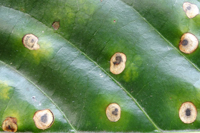 |
Frogeye Leaf Spot
- Frogeye Leaf Spot is a fungal ailment that appears as small, dark, water-soaked spots. They develop into brown spots surrounded by a darker reddish-brown or purple ring. Left unchecked, it can compromise overall plant health, affecting yields and weakening defenses.
- Most notably targeted plants include apple, crabapple and soybean.
|
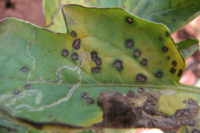 |
Septoria Leaf Spot
- Septoria leaf spot, caused by the fungus Septoria, affects a variety of plants. It manifests as small, water-soaked circular spots with gray centers and dark edges on older leaves, often leading to premature leaf drop, reducing yield and fruit quality.
- Tomatoes, potatoes, eggplants, peppers, and petunias are susceptible to this fungus.
|
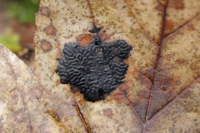 |
Tar Spot
- Tar Spot is a fungal disease characterized by distinct black, tar-like spots forming on the upper surface of leaves, primarily on maple trees. While often alarming in appearance, it’s generally harmless to the tree’s overall health but can lead to premature leaf drop.
|
Different types of leaf spot diseases have specific host plants and unique characteristics, but all involve some discoloration or blemishing of leaf tissue. The exact symptoms can vary, but the presence of irregular or distinct spots is a common sign. Proper identification can help in effectively managing and treating these diseases.
What are the Symptoms?
Leaf spot diseases, whether fungal or bacterial in origin, generally manifest as visible symptoms on the leaves of affected plants. The specific appearance of these symptoms can vary depending on the causative agent and the host plant, but they typically include the following:
- Spots on Leaves:
- Shape and Size: Spots can be round, angular, or irregular in shape and can range from pinpoint size to larger blotches that cover a significant portion of the leaf.
- Color: Initially, the spots may appear as light green or yellow areas, but they can darken to brown, black, tan, or reddish-brown over time. In some cases, a yellow halo might surround the spot.
- Lesions: As the disease progresses, the spots can develop into raised or sunken lesions. In some cases, they may have a papery texture or a water-soaked appearance.
- Pattern: The distribution of spots can be scattered, clustered, or follow the leaf veins, depending on the pathogen and its mode of infection.
- Presence of Fruiting Bodies: In advanced stages of some fungal diseases, you might notice the presence of tiny fruiting bodies (like pycnidia or acervuli) in the center of the spots.
- Holes in Leaves: As infected areas of the leaf die, they might fall away, leaving small holes.
- Premature Leaf Drop: As the disease progresses, affected leaves may yellow and drop prematurely.
- Chlorosis: The tissue surrounding the spots may become yellow, a condition known as chlorosis.
- Distorted Growth: In severe cases or when young leaves get affected, there might be distortion, curling, or twisting of leaves.
- Black streaks or Vein Delimitation: Particularly in bacterial leaf spot diseases, the spots can be delimited by leaf veins, resulting in a blocky pattern.
- Wilting and Blighting: If the infection is severe and widespread, entire leaves or even whole branches might wilt and die.
It’s essential to understand that while these symptoms are characteristic of leaf spot diseases, they can sometimes be confused with symptoms of other plant problems, such as nutrient deficiencies, insect damage, or environmental stresses. Thus, correct diagnosis, possibly with the help of a local plant pathologist or extension service, can be beneficial in addressing the issue effectively.
How to Control and Prevent Leaf Spot?
Controlling and preventing leaf spot diseases require a combination of cultural, biological, and chemical methods. Here are steps and practices to consider:
Cultural Controls:
- Proper Spacing: Ensure plants have adequate spacing to promote air circulation, which helps leaves dry quickly and reduces the conducive moist environment for fungal and bacterial growth.
- Watering: Water plants at the base using soaker hoses or drip irrigation to prevent water splashing, which can spread pathogens. If using overhead watering, do so early in the day to allow leaves to dry quickly.
- Sanitation: Regularly remove and dispose of affected leaves or fallen debris. This reduces the sources of inoculum.
- Crop Rotation: If dealing with annual plants, rotate crops to reduce the chances of pathogens overwintering and affecting the next crop.
- Resistant Varieties: Choose plant varieties that are resistant to leaf spot diseases.
Biological Controls:
- Beneficial Microbes: Products containing beneficial bacteria or fungi, like Bacillus subtilis or Trichoderma, can act as biological fungicides.
- Compost Tea: Regular sprays can help boost plant immunity and suppress foliar disease agents.
Chemical Controls:
- Fungicides: Use protective fungicides, but correct application timing and product selection are critical.
- Bactericides: For bacterial leaf spots, copper-based bactericides can be useful.
Monitoring and Early Detection:
- Regularly inspect plants for early symptoms of leaf spot. Early detection and treatment can prevent widespread damage.
Pruning:
- Prune and thin out dense canopies to improve air circulation.
Avoid Working in Wet Conditions:
- Refrain from handling plants when they are wet since this can spread the disease.
Mulching:
- Use organic mulches like straw or wood chips to prevent soilborne pathogens from splashing onto leaves. Keep some space between the mulch and plant stem to allow for air movement.
Clean Tools and Equipment:
- Disinfect gardening tools, especially after using them on infected plants. You can use a solution of 10% bleach or 70% alcohol.
Healthy Soil:
- Maintain soil health with compost and organic matter, promoting healthy plants more resistant to diseases.
Control Weeds:
- Some weeds can host pathogens. Regular weeding can prevent them from acting as reservoirs.
Avoid Plant Stress:
- Ensure plants are not stressed due to drought, poor nutrition, or other factors, as stressed plants are more susceptible to diseases.
By integrating these practices into a regular gardening routine, you can effectively reduce the impact of leaf spot diseases and maintain healthy, thriving plants.
While every effort has been made to describe these plants accurately, please keep in mind that height, bloom time, and color may differ in various climates. The description of these plants has been written based on numerous outside resources.









